Starting from desire
Discussion on Louis Kahn’s architectural design theory
Ma Yinglin
Louis Kahn, Architectural design, Phenomenology, Form, Desire, Function
Abstract
In 1896, Louis Sullivan put forward the argument that “form always follows function”, which triggered a long-term discussion on the rela- tionship between form and function in the field of architecture. Louis Kahn took a different approach and pointed out that “Desire inspi- res function.” For the first time, the element of “human desire” has been added. This article will be based on the philosophical thinking of “phenomenology”, Combining psychological experiments and actual cases, Try to explore Kahn’s architectural design philosophy. At the same time, the argument that “form influences desire” is proposed, As a supplement to Kahn ‘s point of view.
1. Introduction.
Throughout the evolution of the development of modern architec- ture, Louis Kahn can be said to be a key figure. Regarding Kahn ‘s works, Ieoh Ming Pei said: “Building…… three or four masterpieces are more important than 50, 60 buildings. (architectural design) qua- lity, not quantity.” Indeed, Kahn’s excellent architectural theory and practice play a vital role in promoting the development of modernist architecture and the rise of postmodernism, connecting the past and enlightening the future.
In the context of the Second Industrial Revolution, Louis Sullivan pro- posed: “Form (ever) follows function.” [1] After World War II, The trend of functionalist design spread all over the world.
A design thinking that follows the project specification, proper functional arran- gement and organization has become a global thinking model for promoting architectural education and practice. Modernist spaces often show the consis- tency of globalization. Under the packaging of abstract geometric forms and glass curtain wall , people gradually forget the space sensibility of materials and culture. (Shi Zhiming, 2015:194).
Kahn criticized the socially responsible architects he had enthusiasti- cally supported for using tool rationality to obliterate human spiritual values. In a practical society, his approach is extremely challenging and forward-looking.
Kahn proposed “Desire inspires function.” For the first time, the ele- ment of “human desire” has been added. This is Kahn’s philosophical way of thinking. My interpretation is that it includes Edmund Husserl’s “phenomenology” [2] for the pursuit of the essence of things and Martin Heidegger’s exploration of ontology.
Kahn is known as the philosopher among architects. His theory has the foundations of German classical philosophy and romantic philoso- phy, but also combines modernist architectural concepts and Eastern cultural. However, from a philosophical point of view, phenomenology is the method, although the various meanings of the term depend entirely on the viewpoint of a particular philosopher. According to Husserl, phenomenology is a method of philosophical exploration, and when it comes to Kahn, it is a method of architectural design exploration. The prerequisite of philosophical thinking is honesty, and Kahn honestly looked at the current social situation, human nature, and self at that time. Defend the essence of design as firm as a warrior. Architecture is built for people, we can also interpret it as, what Kahn’s architecture really defends is human nature, and desire is human nature. Since the beginning of mankind, mankind has always added desire to the world in which it lives, giving meaning to this world.
“When Kahn re-examined the world with his divine architectural view, he found that using architecture to solve social problems is lunatic ravings.” David B. Browning, David G. De Longing, 2017: 4) However, most outstanding architects are able to convey certain ideas through their buildings and trigger people’s thinking. Indeed, relying on a buil- ding cannot directly solve social problems, but as an architect with a sense of morality and conscience, you must believe that architecture has the power to influence people’s hearts.
The development of science and technology has opened up a new model of human society, but the two sides of things tell us that defen- ding human nature is the key to human beings not being backfired by science and technology. To this day, Louis Kahn’s architectural theory is still applicable. Kahn’s reflection and persistence in his time, respect for human nature and philosophical thinking are exactly what the architects of our era want to understand and inherit.
Today’s architectural design should be diversified, multi-functional, and try to meet the experience needs of all kinds of people. Just like the forest in nature, both trees and grass have their own living space. The city of the future should neither be the same kind of nursery factory, nor a garden for the rich to make grandstanding, Instead, it should return to the essence like Heidegger’s “ Dwelling in the land of poetry on” 3. Re-establish the connection with nature, history, and culture, and build a diverse, gentle, and poetic living environment.
2. Contextualization of the problem.
Due to economic development and technological advancement, Chinese cities have achieved sustained construction and develop- ment in recent years. But what is disturbing is that in order to conti- nuously pursue high efficiency, standardization and digitization have gradually dominated the design ideas of urban construction: “people” have become human resources, and “water” have become hydraulic resources; plants are called “Green Rate”. [4] People’s living space is called “ Plot Ratio”[5]····etc. Husserl once warned that it is not objective to use mathematical methods to calculate the world. The advanced nature of the city should be reflected in the degree of civilization of the city, including the cognition and connection of history, culture, nature, and itself. Urban construction has long been dominated by simple data, and the most obvious consequence is: the serious ho- mogeneity of the urban appearance (form).
What is dumbfounding is that as the phenomenon of urban homo- geneity has attracted attention, the newly built buildings in recent years have quickly moved to the other extreme: the pursuit of formal grandstanding, pursue unprecedented heights, strange shapes or extravagant materials. The price paid for this is high construction and operating costs, as well as damage to the environment. And I think that apart from stimulating people’s excessive desires, these grandstanding buildings cannot essentially improve the problem of urban homogeneity. It is undeniable that the driving force of human development so far is desire, but excessive desire will bring destruc- tion. Russian writer Pushkin’s fairy tale “The Tale of the Fisherman and the Fish” warns the world that if you allow your desire to develop too much, you will end up with nothing.
Louis Kahn said: “Needs are easy to satisfy, but desires are difficult to realize.” Architectural design should reflect two parts at the same time: one is the visible “needs” and the other is the invisible “desire”. The two need to be balanced.
Heidegger uses “Dasein” to describe the essence of human existence. “Dasein” literally means “being here (that)”. The meaning of this sen- tence is the combination of body, mind and environment, and none of them are indispensable. If a city makes its residents lose themselves, people cannot locate and identify themselves, and there is no heal- thy social space, without the past, present and future, at the same time, being constantly driven by excessive desires, the boundaries of rationality will gradually disappear, and eventually the entire social structure will collapse.
3. Statement of the hypothesis.
“Existence can be obscured so far, even existence is forgotten, and the question of existence and its meaning is no one cares about.” (Martin Heidegger, 1999: 42) “At the beginning of the school, one person was sitting under a big tree. At that time, he did not know that he was a teacher. He discussed his knowledge with some people, and they did not know that they were students… Some spaces were set up. The earliest school.” Kahn told the story and put forward the point of view of “desire inspires function”, which is the architectural embodiment of the phenomenological view of “returning to the thing itself”. On this basis, I want to continue to propose “form influences desire” as a supplement to Kahn’s view, so that we have a relatively complete understanding of Kahn’s argument.
The development of many contemporary cities has surpassed peo- ple’s real needs for cities, or the meaning of the city itself has been forgotten by people nowadays. Assuming that the architectural form can affect people’s desires, then through architectural design, the city can be guided to develop in a more ecological and civilized direction, which is conducive to the restoration of nature and cultural heritage. One way for architects to design an environmentally friendly building or plan a community is to consider the environmental protection of the building itself (construction materials, operating energy consump- tion, etc.), and another way is to stimulate people’s desire for envi- ronmental protection through architectural forms. The combination of the two is the correct way. In contrast, the second method even affects the spread in a wider range, and the effect is more prominent and long-term.
4. Discussion
Buildings and urban environments can affect people’s mood and living conditions, and today’s scientific community has a lot of supporting evidence. Human desire puts forward the demand for space function, that is, “ desire inspires function”, and architectural form can also affect people’s desire in turn, because human is a combination of body, thought and environment, that is, “form influences desire”.
How much influence does the form of architecture have on human society? The following are some experiments by neuroscientists and psychologists. These experiments confirm the potential cognitive impact of architecture on urban residents.
In the 1950s, The pruitt-Igoe housing complex in St Louis, Missouri, whose 33 featureless apartment blocks – designed by Minoru Yamasaki, also responsible for the World Trade Center – quickly became notorious for their crime, squalor and social dysfunction. Critics argued that the wide open spaces between the blocks of modernist high-rises discouraged a sense of community, particularly as crime rates started to rise. They were eventually demolished in 1972.
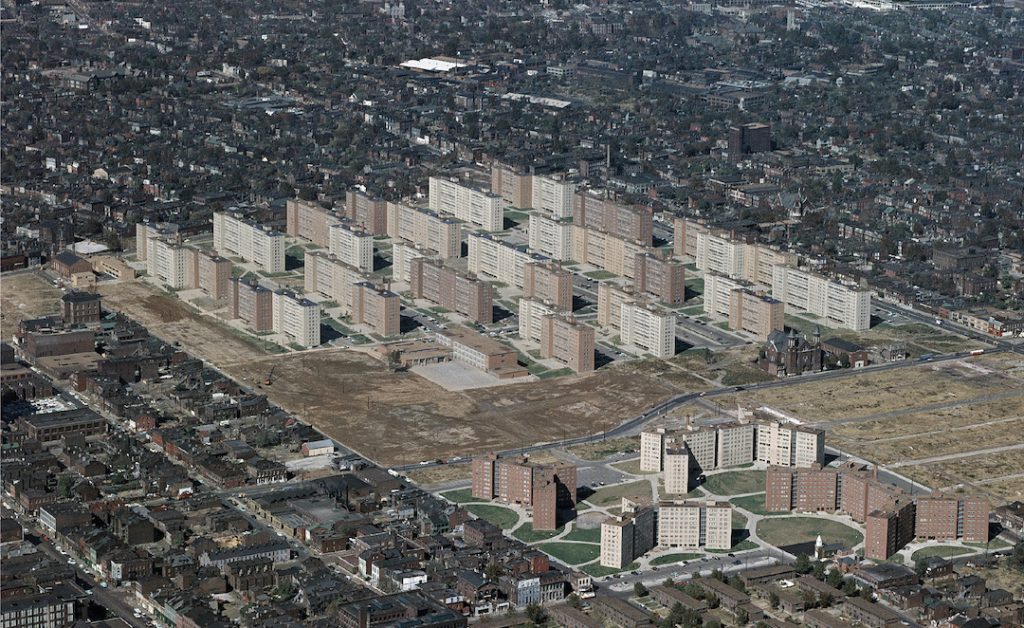
figure 1, Pruitt-Igoe housing complex

figure 2, In April 1972, Pruitt-Igoe housing complex was demolished by blasting
Today, thanks to psychological studies, we have a much better idea of the kind of urban environments that people like or find stimulating. Some of these studies have attempted to measure subjects’ physio- logical responses in situ, using wearable devices such as bracelets that monitor skin conductance (a marker of physiological arousal), smartphone apps that ask subjects about their emotional state, and electroencephalogram (EEG) headsets that measure brain activity relating to mental states and mood.
“This adds a layer of information that is otherwise difficult to get at,” said Colin Ellard, who researches the psychological impact of design at the University of Waterloo in Canada. “When we ask people about their stress they say it’s no big deal, yet when we measure their physiology we discover that their responses are off the charts. The difficulty is that your physiological state is the one that impacts your health.” Taking a closer look at these physiological states could shed light on how city design affects our bodies.
One of Ellard’s most consistent findings is that people are strongly affected by building façades. If the façade is complex and interesting, it affects people in a positive way; negatively if it is simple and monotonous. For example, when he walked a group of subjects past the long, smoked-glass frontage of a Whole Foods store in Lower Manhattan, their arousal and mood states took a dive, according to the wristband readings and on-the-spot emotion surveys. They also quickened their pace as if to hurry out of the dead zone. They picked up considerably when they reached a stretch of restaurants and stores, where (not surprisingly) they reported feeling a lot more lively and engaged. (Michael Bond, 2017)
Another case about the positive impact of architectural forms on peo- ple is a small town called Palmitas in the Pachuca region of Mexico. This is a typical hillside suburb of Mexico, And there are problems of high crime rates and youth violence. In order to reduce the negative emotions of young people and solve the problem of juvenile delin- quency, the local government invited the street artist team Germen Crew to plan graffiti in the town, hoping to restore the peace and vitality of the community here by painting the town.
After investigating, observing, and asking the residents about the colors and patterns they like, the artists finally decided to use bri- ght and pure colors to decorate the town. Each color represents a kind of emotion and personality. Bright colors can arouse emotional fluctuations, while dim colors can only bring depression and gloomy emotions.
With the help of locals, Germen Crew managed to paint 20,000 square meters of graffiti art on the wall in 190 colors. This has had a very positive impact: the project affected 452 families and 1,808 people, completely eradicating youth violence in the town, the local crime rate was greatly reduced, and bloodshed incidents dropped sharply, The community was quickly filled with mutual assistance and an atmos- phere of creation, and it quickly became an artistic tourist attraction in Mexico.
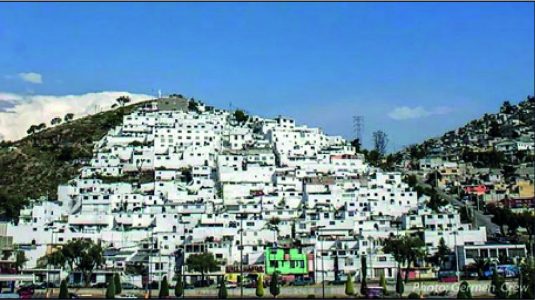
figure 3 ,Before the town transformation
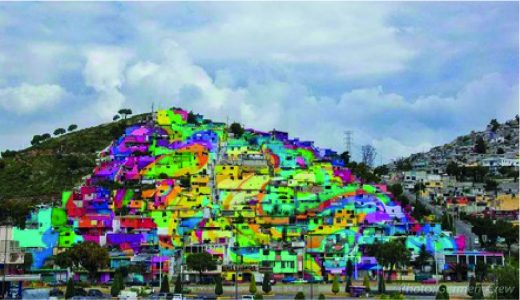
figure 4 ,After the town was transformed

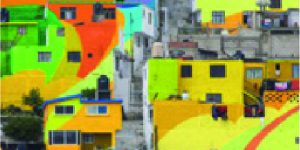
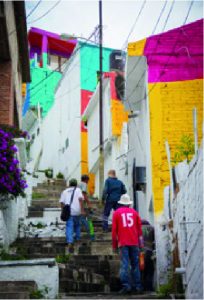
figure5-7 ,After the town was transformed
Tell a story that I personally experienced. A few years ago, I traveled to Europe with a few colleagues in the design industry. When we went to Cologne, Germany, we visited the Cologne Cathedral. Everyone was overwhelmed by its grandeur and exquisite details. It was Sunday, and we left the church before the mass started, and suddenly found that one person was missing, and we couldn’t get in touch in any way. Soon the designer came out of the church with tears on his face, emotio- nally unable to hold on himself, he said that he had finally found the home of his soul. Before long, he became a believer.
Classical European church buildings are very much in pursuit of hei- ght, overcoming great difficulty to build a towering and vertical spire. It is said that the higher the spire, people feel that they can get closer to God. This may be because human beings are born with fear and worship of the sky and the untouchable heights. Beauty comes from marveling and comprehending, marveling leads to visual stay, compre- hension prompts thinking and cognition. I think this is a typical case of the influence of architectural form on the human heart (desire).
It cannot be denied that the influence of architectural forms or other art forms on people’s hearts is difficult to accurately measure and calculate in science. For example, science cannot measure and cal- culate the value of painting. The same painting is shown in front of different people. Some people see different color blocks and chemical elements, but some people can feel a magical world. The composi- tion of people’s eyes is the same, but the brain conveys so different information. Merleau-Ponty said: “Painting confuses all our categories, such as essence and existence, imagination and reality, and the visible and the invisible.” (Merleau -Ponty, 2007:49) “The characteristic of the visible is that it has a strictly invisible level.” (André Robinette, 2006: 43) The same is true for architectural design.
Therefore, in addition to the visible functions of sheltering people from wind and rain, comfort and safety, architectural design must also embody invisible desires. Both are indispensable. In a sense, the invisible part is more valuable, but the invisible part will never be reflected in the project specification.
Kahn uses serenity and light to symbolize the duality of external form and internal desire. Serenity is the desire for existence, and light gives this form of existence. The process of inspiration is just like passing through this mottled channel of light and shadow. In his exploration of architecture, Kahn experienced a world different from ordinary thinking. People are the unmeasurable center, intuition guides the pace of creation, and buildings have the will to exist before they are formed. The essence of Kahn’s design concept is to seek advice from the physical nature of the ruthless world, and to integrate the crea- tor’s affectionate performance, so his buildings often reveal a touch of holiness.
Inductive Kahn’s architectural theory includes “reflection”, which is a thinking method proposed by Husserl’s transcendental phenomeno- logy: That is to Insight the unique way of manifesting the phenomenon of things, and restore the true state of the phenomenon. Kahn made a profound reflection on the architecture itself, returning to the original meaning of the beginning of human construction, which he called the “origin.” The origin is always uncertain, especially when we tend to feel closer to it, but find that we are farther and farther away, so Kahn will besoexcitedwhenhefindstheorigin.AsNeruda said-throwyourself into the sea, and then fish yourself out.
The “dwelling in the land of poetry on” proposed by Heidegger’s exis- tential phenomenology reflects on the way of human existence on the earth. And these thoughts are summarized into various human desires in Kahn: the desire to gather, the desire to learn, and the desire to be healthy; the corresponding forms he believes are: the form of the street, the form of the school, and the form of the green space.
For Kahn, form has a deeper meaning, which is equivalent to the essence of architectural will. The purpose of design is to embody it, and form is what people want. Therefore, although form cannot directly interfere with the development of human events, it can play a role in influencing the human heart. Form expresses desire, and form influences desire.
Kahn expresses the obscure philosophical language in a straight- forward architectural form. “Art is a philosophical practice, and phi- losophy is an aesthetic practice” (Alva Noë, 2020: Chapter 11) Kahn’s architectural design fully reflects the meaning of this sentence. Philosophy makes people think about life, but what is the meaning of thinking about life?
Plato’s answer is: “The value of philosophy does not originate from the result of debate. Its value lies in changing our ideas.”
“Philosophy does not change anything, it listens to things to maintain their in- herent state; But it reorganizes the way we think and reason, and philosophy changes us. The purpose of philosophy is not to discover, but to comprehend… The work of art, like the work of philosophy, is to reorganize us. And this kind of reorganization, this kind of work, its purpose is also comprehend.” (Alva Noë, 2020: Chapter 11)
Therefore, the biggest gain from the discussion of Louis Kahn’s archi- tectural theory is an insight. One person’s understanding is too small for this world, but through architectural design, this understanding can affect more people.
5. Conclusions
Based on the philosophical thought of “phenomenology”, this article combines the results of psychological experiments and actual cases to try to explore and interpret Kahn’s architectural theory. And put forward the view that “form influences desire” as a supplement to Kahn’s view of “desire inspires function”, and finally got a relatively complete description, namely: “form influences desire, desire inspires function.” In fact, this is also the answer to the architectural design method.
Architectural design is the response to people’s own desires in the process of understanding the history, culture, nature and society of the site. Various factors gradually converge into a main line, through which the form and function of the building are naturally formed, and finally found and expressed by the architect. In this process of cons- tant search, the architect himself will also be influenced and shaped, and then again through architectural design to influence others.
It can be seen from this that “human desire” is the key point that con- nects “form” and “function”, and is the origin of architectural design. It is not appropriate for architectural design to simply start from form or function. First of all, we must start from human desires to find the essence of architecture. It should be noted that the people mentioned here not only refer to the users, but also the surrounding residents, pedestrians passing by, and all people who may be affected by this building.
Note
1. Form follows function is a principle related to architecture and industrial design from the end of the 19th century to the beginning of the 20th century. It means that the shape of a building or object should be basically related to its intended function or purpose.
2. Phenomenology, (derived from the Greek phainómenon, meaning “appearing things”; and lógos, mea- ning “research”) is one of the most important philosophical schools of the 20th century. It was developed by the German philosopher Hussein Was officially founded.
3. People, Poetic Dwelling” The original text comes from the poem of Del and Lin. Heidelger regards art as the opposite of technology, and since the end of the 1930s, based on Holderlin’s poems, he has compre- hended an alternative to the purely technical way of connecting the world.
4. The rate of green space is an urban planning indicator of the proportion of green space within a certain range. Its specific definition and calculation method vary from region to region.
5. Plot Ratio (Floor Area Ratio/Volume Fraction) refers to the ratio of the total above-ground building area of a community to the net land area.
13 Starting from deSire: diScuSSion on LouiS Kahn’S architecturaL deSign theory VOL III 2022
Images, charts, graphic materials
Figure 1, Pruitt-Igoe housing complex
https://commons.wikimedia.org/w/index.php?curid=5584780
Figure 2, In April 1972, Pruitt-Igoe housing complex was demolished by blasting
https://commons.wikimedia.org/w/index.php?curid=6875789
Figure 3, Palmis town before the town transformation https://www.boredpanda.es/pueblo-palmitas-mu- ral-germen-crew-mexico/?media_id=pueblo-palmitas-mural-germen-crew-mexico-1
Figure 4-7, Palmis town after town transformation https://www.boredpanda.es/pueblo-palmitas-mu- ral-germen-crew-mexico/?media_id=pueblo-palmitas-mural-germen-crew-mexico-1
References
Martin Heidegger, 1999 “Revision of Being and Time [M]”, Chen Jiaying (translated). Beijing: Sanlian Books- tore
Andre Robinette, 2006 “The Ambiguous Philosophy- Merleau-Ponty Biography”, Song Gang (translated). Beijing: Peking University Press.
Maurice Merleau-Ponty: 2007 “Eye and Heart”, Yang Dachun (translated) . Beijing: The Commercial Press
David B. Browning, David G. Lonning, 2017 “Louis Kahn: In the Kingdom of Architecture (Additional and Revised Edition)”, Ma Qin (translated) . Nanjing: Jiangsu Phoenix Science and Technology Press
Shi Zhiming, Liu Fangjia, 2015 “The Philosopher among the Architects of Louis Kahn” Nanjing: Jiangsu Science and Technology Press
Alva Noë , 2020 “Strange Tools: Art and Human Nature”, Dou Xuxia (translated) .Changsha: Hunan Science and Technology Press http://jxz1.j9p.com/pc/qtgjysrx.pdf
Michael Bond, 2017 «The hidden ways that architecture affects how you feel». London: BBC.com https:// www.bbc.com/ukchina/simp/vert-fut-40431128